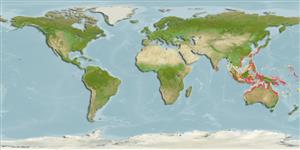Common names from other countries
Environment: milieu / climate zone / depth range / distribution range
Ecologia
marinhas; estuarina demersal; não migratória; intervalo de profundidade 0 - 20 m (Ref. 86942). Tropical
Western Central Pacific: Philippines, Borneo, Singapore, Celebes, Papua New Guinea, New Georgia and Australia from the Northwest Shelf to Brisbane.
Tamanho / Peso / Idade
Maturity: Lm ? range ? - ? cm
Max length : 58.0 cm TL macho/indeterminado; (Ref. 9790); common length : 30.0 cm TL macho/indeterminado; (Ref. 9790); peso máx. publicado: 655.00 g (Ref. 3132)
Espinhos dorsais (total) : 9; Raios dorsais (total) : 11; Espinhos anais: 0; Raios anais : 11. Prominent pit present behind upper eye. Preopercular spines short, upper two subequal. Infraorbital ridge usually smooth over eye. Suborbital ridge bearing 1 spine below rear of eye. Dorsal fin IX or I,VIII. Dermal papillae (usually 6-9 in adults) on upper surface of eye, longest branched and reaching well above supraorbital ridge. Short dark streaks usually crossing rays in dorsal and caudal fins.
Inhabits shallow rocky coastal areas frequently associated with seaweed beds and mangroves, most commonly at depths of less than 5 m (Ref. 9790). Also found on sand bottoms (Ref. 3132).
Ciclo de vida ou comportamento de acasalamento
Maturities | Reprodução | Spawnings | Egg(s) | Fecundities | Larvas
Allen, G.R. and R. Swainston, 1988. The marine fishes of north-western Australia: a field guide for anglers and divers. Western Australian Museum, Perth. 201 p. (Ref. 3132)
Status na Lista Vermelha da UICN (Ref. 130435)
CITES (Ref. 128078)
Not Evaluated
Ameaça para os humanos
Harmless
Uso pelos humanos
Pescarias: pesca de subsistência
Ferramentas
Relatórios especiais
Baixar XML
Fontes da internet
Estimates based on models
Preferred temperature (Ref.
115969): 24.7 - 29.3, mean 28.6 (based on 2366 cells).
Índice de diversidade filogenética (Ref.
82804): PD
50 = 0.5625 [Uniqueness, from 0.5 = low to 2.0 = high].
Bayesian length-weight: a=0.00776 (0.00440 - 0.01371), b=3.05 (2.88 - 3.22), in cm Total Length, based on LWR estimates for this species & (Sub)family-body (Ref.
93245).
Nível Trófico (Ref.
69278): 4.0 ±0.7 se; based on size and trophs of closest relatives
Resiliência (Ref.
120179): médio(a), tempo mínimo de duplicação da população 1,4 - 4,4 anos (Preliminary K or Fecundity.).
Fishing Vulnerability (Ref.
59153): Moderate vulnerability (43 of 100).
